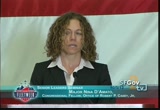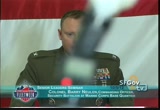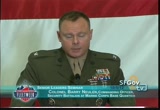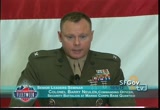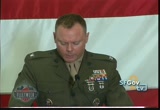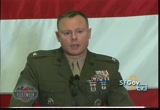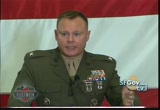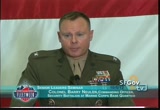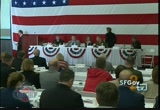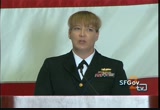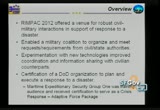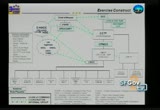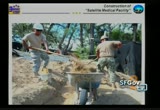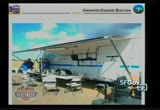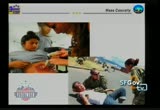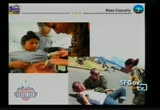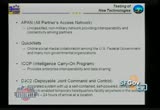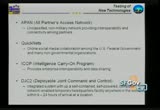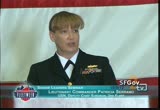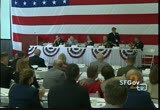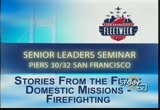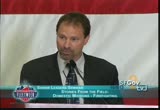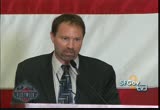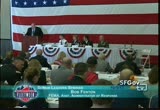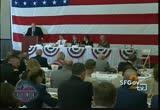tv [untitled] December 12, 2012 4:30am-5:00am PST
4:30 am
arrived. and i appreciate your time, appreciate your attention. thank you. . (applause). >> thank you, nita, following along we're going to have colonel barry newland. >> thanks, lewis. i'd like to thank nina for doing a great job of setting the stage so i don't have to go through and do the same thing. so great job. i do not in these slides, any pictures, i will only speak briefly. lewis asked me to come and speak on this last day of the fleet week discussions because he thought that my experiences with the afghan police might shed some light on the current news, the troubling news out there of all the attacks on our uniformed personnel by uniformed afghans and it's only been pretty
4:31 am
recent in the news that the increases happened so he thought i might be able to add some background information on that. for about 6 months i was the senior advisor to the chief of police for kabul city police department in the capitol. back at the end of 2009-2010, we real laiz that we probably spent a great deal of money and effort on trying to transform the afghan army and we probably neglected the police force. and the reason that realization was so important was because the police in afghanistan are not what we consider traditional police. there's a number of police officers in the audience that could understood this. in afghanistan, the police are not so concerned with traffic
4:32 am
control, traffic is insane in afghanistan. so you'll see traffic lights but they don't work. they are not so concerned with chasing criminals. what they are concerned with is protecting themselves and protecting the villagers. in a lot of places throughout afghanistan, the police might be the only thing that's separating the villagers from the taliban. they are what would be more considered a paramilitary source. -- force. ufrptly prrp unfortunately they are not trained nearly as well as the taliban, they don't have the same equipment and they are greatly outnumbered by the enemy moving freely through afghanistan. so the focus of effort needed to be switched to say how do we fix that because the populations are concentrated in the districts and we needed to look at how we would fix the police in the
4:33 am
districts, how we would train these folks and figure out who's, who should be in there and who shouldn't be. when i was in kabul, i worked very closely with the chief of police up there and with all the different sections of the police department in the capitol. kabul is made up of about 5 million people in the capitol, it's a very concentrated area, very congested. there are about 15,000 police officers in kabul, just the capitol city alone. trying to get your arms around that, it's really difficult to explain. here in the united states we have background checks, people know where you've been, what you've been doing since you were born. so by the time you are 18 years old, everybody knows who's who, you can go on to your facebook account and figure out what you've done for your last 18 years. you don't have that in afghanistan. a lot of these
4:34 am
people that come in and want to be soldiers or policemen can only be veted by the elders in the village. so you don't know who you are. what we tried to do was bring in bio metrics and you'll probably read about that now, how do we reset and establish a good background way to determine who should be armed and who should be in uniform over there and who shouldn't be and that's some of the things we were doing. corruption is very real. but it's acceptable. we don't like it but in afghanistan, people accept corruption as a way of life. so another challenge was how do we change the mind set, how did we make people realize it's not right to do the kind of things they were doing which was grafting, taking money and being a corrupt society, taking
4:35 am
money from people just to move throughout their town. one of the ways we did that was trying to be sure we took people and spent time with the police officers themselves. we probably spent way too much -- too much emphasis on contractors early on and the problem with that was we would send our contractor force out, they may have been the only people out there doing the training, and what would happen when the threat increase took place, the contractors would remain on the safety of the compound. this could go on for days or weeks. the frustration came from the afghans because they relied on that training on a daily basis. so the person that was with them training them may not be there now for days or weeks at a time. so we kind of changed that around and said we need to take our armed personnel and put them out there and spend time with these folks day in
4:36 am
and day out, not only built trust between us and the afghans but it gave them the ability to prg on a daily basis. so the other frustration was the coalition effort. there was a lot of people with great intentions willing to help shared by many different countries. the frustration was many different countries, there's many different ways of doing things. so we would be out there telling the afghans, this is how you conduct police operations, this is how we do police training, this is how you hold your weapon and engage the enemy, and then several weeks later another force would come in and not that it was necessarily wrong, but it was different. so from the afghan perspective, incredibly frustrating to understand where they are going and what they need to be doing and what is right and what is wrong. so in closing if someone were to ask me from 2010 to where
4:37 am
we're at now, is there hope i would say, yes, there is. as we stand down our combat forces and shift to an advisory and a training role i think we're going to be able to take our lessons lerbed -- learned and ensure that we can continue to build on what we've done. there were some great success stories. one of the things we worked on a lot was trying to bring women into the policing, something that was unheard of only a few years ago. nina talked about the teachers but there was women who wanted to be police officers, there was women who had death threats against them from their own families and were actually serving as police officers in hiding because they wanted to do something that was important. so that was, to me that was a huge success story. but i think what we need to do is reset our vetting process,
4:38 am
put more bio metrics in and ensure that we are standing shoulder to shoulder with the afghans as they try to build and then we teach the afghans to help themselves. and i think that's where we're going to see our success down the road. thank you. (applause). >> thank you, barry, now it's lieutenant commander serrano and captain napalitano >> good morning, everyone, i'm pleased to be here today to tell you about an exercise we conducted this past summer in hawaii as part of rim of pacific exercise which involved 22 participating nations and this offered us a venue to be able to conduct a humanitarian and disaster relief exercise with all the different partners that we had together and
4:39 am
collaborating with this exercise, this offered a perfect opportunity for us to introduce the military capabilities and interaction in exchange with our civil military partners as well. the exercise was located on oh oahu we had used that island as a fictitious island of chianti where we wanted to do a humanitarian response but it also provided us an avenue for the state-wide partners, the civil hawaiian partners, to be able to exercise their exercise as well. this exercise also allowed us the opportunity to intro daus a lot of technology to help with the interoperatability of the civil military exercise. one of the main goals that we had for this was to allow our
4:40 am
military a crisis response adaptive force package and opportunity to allow their training and certification in providing the most appropriate military expeditionary force for that scenario. one of the things that we realize in the military when we do these exercises in a foreign humanitarian response, that a lot of our military capabilities are not just for overseas foreign disasters but it also allows the military to be trained and certified to respond to local domestic disaster situations as well. i had mentioned that we had 22 nations participating in rimpac and this slide is a representation of the military
4:41 am
and civilian partners that we had participating in this event. and we had many, many international partners and we had a lot of domestic partners: medical and military editionary partners as well. okay, this is our command and control slide. we took a lot of care to get this right. we wanted to make sure that we portray that we're there to assist and support the government that has requested our service to be there. we wanted to make sure that our forces that are responding in a military environment go in with the right knowledge and the right attitude and you can see the tactical unit at the bottom there and the crisis response civil military operations center that was there to provide the command and control of those tactical units responding on the military
4:42 am
side, this provided a perfect environment and opportunity for them to be able to interact with the civilian partners and provide the most appropriate response and understanding. very complex and again i just want to reiterate that the military, we know when we're responding in this type of environment that we're not coming in with the heavy capability and saying don't worry, we're here to help you and take over, we're here to complement and support you with the appropriate ways that you request our needs. the next few slides that i'm going to go over here shows some of the military capability and how some of those responses that we did during this exercise can also be applied at home in a domestic environment such as a response to maybe an earthquake here in san francisco. so the first part up there, you see a slide of some of the military that's getting ready to do some
4:43 am
mapping and underwater environment general location to see what's going on with the piers, and then the next picture down here, the military also has the capability to bring response to be able to clear the ports and the channels to be able to open it up for maritime traffic in the bay. this part, this event, was the satellite, construction of a satellite medical facility. some of our military capability is we have the right engineers and people that can go in and rebuild infrastructure and support. so one of the things they did during this exercise, they actually went in there for about a week-long event and actually constructed a building and this also helps us it
4:44 am
restore capability to wherever we are responding to. this shows a lot of different response here. this is our urban search and rescue event that was part of the overall exercise. we had a lot of different partners that responded to this rubble pile. we had urban search and rescue, u.s. coast guard, and this provided an opportunity for our military to work with the federal and state partners there in learning how to interact with their agencies and also being able to learn some of the different capabilities that they have in using their equipment. we also had some medical partners there where they were able to locate and evacuate the medical patients and that also showed a great partnership.
4:45 am
this is the health care association for hawaii and this is the part of the agency that helped us coordinate the medical response part of this. they were able to conduct a 50-bed disaster medical assistance team hospital on the island of oahu and this allowed the state of hawaii to be able to exercise their state-wide disaster drill. one of the things that hawaii has never been able to do is to be able to practice together in one live exercise. they have all of their processes, how they're going to respond in a local disaster situation, but they have never been able to really put that to use. and being able to partner with us during the rimpac exercise offered them the opportunity to do that.
4:46 am
we also had a lot of civil military interaction by us providing a lot of capability for them to be able to exercise their disaster plan as well. you see some patients here in the moulage. they were able to moulage and fake wounds and put triage information on over 125 casualty actor patients. and we were able to triage them tlau that 50-bed hospital system in hawaii and then they were evacuated to area hospitals for the state of hawaii, one of their capability gaps in the -- during their disaster situations is going to be the routes of evacuation and with the military's response providing the helicopters in an
4:47 am
air evacuation, we were able to go ahead and test that response system. we were able to send patients to 13 area hospitals through that air evacuation and we had over 23 participating hospitals in different scenarios that were participating. we had the state of hawaii was also able to process over 300 patients through their patient tracking system. so the hospitals were able to use the patients, actually the medical staff from their area hospitals to provide the number of patients that went to each hospital and that provided each hospital's own casualty scenario. again you see some of these pictures here, the military preparing these civilian patients for transfer. we even went as far as
4:48 am
evacuating patients to maui the busses down there are the state of hawaii's bus evacuation system which are also used in evacuation. so this convenient tue, this vignette of hadr disaster exercise for hawaii also allowed us the opportunity for testing technology for that information sharing and interoperatability. apm was an online collaboration where we were able to share information and learn how to communicate with each other. one of the things that we realized is we have a problem with interchange of information where we actually are able to share that. and that was one opportunity that we were able to do that. quick net also participated
4:49 am
with us, allowed us to be able to have civil social interaction with the military and have us be able to interchange with them and knowing what type of response we had. intelligence carry on program and deployable joint command and control are two of the systems that were used by the military to collect information and organize it appropriately so that we were able to respond and interact with the civilian agencies. so for the take aways, it provided us an opportunity for real exchange and interaction. the military has a lot of capability and sometimes we don't always know how best to modify that in an appropriate response and being able to get together and practice the situation allowed us to understand each other better. the lessons learned:
4:50 am
throughout the exercise a lot of lessons learned were gains and we're taking those lessons and applying them to real processes where we have interchange and response. 18 months of planning allowed us certain benefits as well. we were able to look at the capabilities that each other brought to the table in these type of environments and we were able to really take those and learn more about each other for future responses. we were able to take and provide a taylored response package to better serve the customer. again, we don't want to go in with a full package that the state or civil environments aren't really asking for, we want to be sure it's taylored appropriately and it's responsive and timely.
4:51 am
we also had the humanitarian assistance coordination center. that's the place we were able to take the non-governmental agencies and the hoetion nation international agencies and have them interacting and coordinating with the military folks so that we were able to provide an understanding of how we all work together. so if you want additional information, if you want to talk to captain napalitano, he is the commanding officer for the expeditionary training group, and he is the -- in charge of the people that train and certify that crisis response adaptive force package. his folks also put together the different events for this, for the exercise. the apan provides us an opportunity to be able to share this information with others
4:52 am
who want to share the information and be able to share what we did online and you are more than welcome to do a search for that, as well as join that access site and learn some of our products that took us through this week-long exercise. and then you can also google this and there's a lot of different social news stories online that can provide the information as well. thank you very much. (applause). >> all right, that's our panel. we're going to take a break right now, just a short break for 10 minutes, and the lunch is just like yesterday, lunch is going to be dropped at the tables and then everybody come back and we'll start with our next panel discussion, it's a working lunch, and the
4:53 am
panelists i'm sure they will be circulating so if you have some questions for them, please feel free to approach them. thank you very much for joining us, admiral. (applause). from secretaries and generals to marin county search and rescue over there to nert members, it's a great mix of people and i think that integration is crucial because when we're preparing before during and after a disaster response, everyone in this room has a role to play in one way or another. and it's a great mix. and having been a former fire fighter this topic is important to me. when you think about one point, 1 million fire fighters around the country, they take 2 million calls a
4:54 am
year or more to help people in times of need. 63,000 wild fires get beyond their initial attack capability every year, burning over 6.7 million acres. there are over 95 percent effective, they do a great job, but every so often you get that season or that issue that is going to escape or go beyond their ability to stop it right away and right now currently the u.s. forest service that helps provide a lot of air resources and seasonal fire fighters is at the point at the end of that season where every pay period they have to justify keeping those air aviation contracts in place. when you come to the end of the season like this, they are going to have to start taking reductions on the rest of the year for those air tankers, those helicopters and the seasonal fire fighters. when you talk
4:55 am
to kim sakaras back there, the cold front that is about to hit us up here means hot dry winds in state of california. that fact is no stranger to people here on the panel. it doesn't take much to fan hot, dry vegetation that has been soaking in that hot sun. when i say soaking, it means it gets the moisture level so low where it's kindling in the forest. you have more people moving in, more vegetation growing, it's a recipe for nature trying to do its thing and people in the way. so with this, it takes a lot of support whether we're talking about the fire lines, behind the fire lines or been above the fire lines to provide that support. it takes a whole mix of people whether it's the
4:56 am
department of defense and even fema having roles to play in that. bob fenton, the assistant chief of fema, used to be the division chief in division 9. he is no stranger to this area, born and raised here, this is his home and so he does have a care and an interest in this community and beyond. and so with that it is hard to fill being his replacement at the regional level because not only to fill his shoes all the great work he did in this region, but also because when you see the size difference, it's a little hard to fit in there. but this this i want to introduce bob fenton, the response head for fema coming in from dc to help support this and moderate the panel. thank you. (applause). >> well, appreciate it.
4:57 am
appreciate the opportunity to be back with friends and back in san francisco. and i appreciate the opportunity to be your lunch speaker. as i always say, lunch is one of may five most important meals of the day so thank you for that. let me introduce my panelists. here to my left, we have a great group here to talk about stories from the field with regard to fire and 10 years of lessons learned being applied. first to my left, ray chaney, cal fire incident battle xwrupb chief. to his left, colonel laura yeager, 40th combat aviation brigade. to her left, commander steve everett, to his left lieutenant colonel dana, marine corps installation west. thank you.
4:58 am
let me go ahead and start off by talking a little bit and just going back over some of the discussions yesterday that i think are going to play into this discussion. we had vice admiral beeman talk a little bit yesterday about capabilities and vice admiral zunkoff talked about partnerships, unity of effort, unity of command. mayor lee talked about dod efforts, expertise, community efforts and as we go into all those discussions today you will see best practices applied during the 10 years from those fires. i have the pleasure of working for administrator fuget in fema headquarters. fema's role is to coordinate response between state and local governments and his focus, his direction to us
4:59 am
really comes down it 3 things. he asks us to always plan for the worst case, the maximum of the maximums and it's go to see the department of defense is incorporating this within the catastrophe policy that was spoken about a little earlier. no. 2, he asked us to sppbld and are able to stabilize an incident within 72 hours. his mantra is think big, go big, go fast but not fast. 3, he asks us to do this within a whole community approach, not only it make sure we utilize the whole community in the response because there's much more responders past the federal-state responders. there's the public being responders and there's many others, private industry need to be in that so we try to
78 Views
IN COLLECTIONS
SFGTV2: San Francisco Government Television Television Archive
Television Archive  Television Archive News Search Service
Television Archive News Search Service 
Uploaded by TV Archive on

 Live Music Archive
Live Music Archive Librivox Free Audio
Librivox Free Audio Metropolitan Museum
Metropolitan Museum Cleveland Museum of Art
Cleveland Museum of Art Internet Arcade
Internet Arcade Console Living Room
Console Living Room Books to Borrow
Books to Borrow Open Library
Open Library TV News
TV News Understanding 9/11
Understanding 9/11